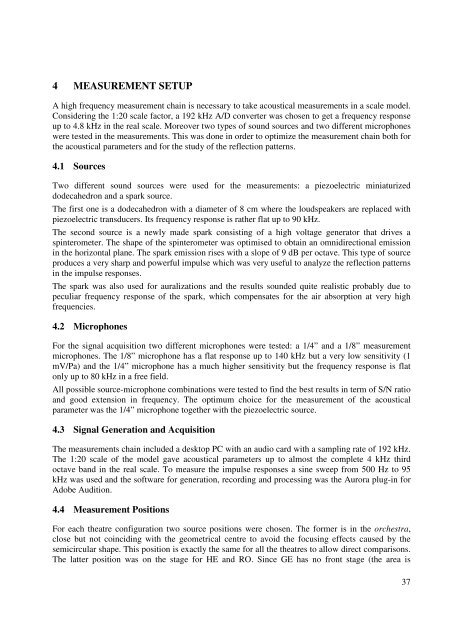ERATO Proceedings Istanbul 2006.pdf - Odeon
ERATO Proceedings Istanbul 2006.pdf - Odeon
ERATO Proceedings Istanbul 2006.pdf - Odeon
Create successful ePaper yourself
Turn your PDF publications into a flip-book with our unique Google optimized e-Paper software.
4 MEASUREMENT SETUP<br />
A high frequency measurement chain is necessary to take acoustical measurements in a scale model.<br />
Considering the 1:20 scale factor, a 192 kHz A/D converter was chosen to get a frequency response<br />
up to 4.8 kHz in the real scale. Moreover two types of sound sources and two different microphones<br />
were tested in the measurements. This was done in order to optimize the measurement chain both for<br />
the acoustical parameters and for the study of the reflection patterns.<br />
4.1 Sources<br />
Two different sound sources were used for the measurements: a piezoelectric miniaturized<br />
dodecahedron and a spark source.<br />
The first one is a dodecahedron with a diameter of 8 cm where the loudspeakers are replaced with<br />
piezoelectric transducers. Its frequency response is rather flat up to 90 kHz.<br />
The second source is a newly made spark consisting of a high voltage generator that drives a<br />
spinterometer. The shape of the spinterometer was optimised to obtain an omnidirectional emission<br />
in the horizontal plane. The spark emission rises with a slope of 9 dB per octave. This type of source<br />
produces a very sharp and powerful impulse which was very useful to analyze the reflection patterns<br />
in the impulse responses.<br />
The spark was also used for auralizations and the results sounded quite realistic probably due to<br />
peculiar frequency response of the spark, which compensates for the air absorption at very high<br />
frequencies.<br />
4.2 Microphones<br />
For the signal acquisition two different microphones were tested: a 1/4” and a 1/8” measurement<br />
microphones. The 1/8” microphone has a flat response up to 140 kHz but a very low sensitivity (1<br />
mV/Pa) and the 1/4” microphone has a much higher sensitivity but the frequency response is flat<br />
only up to 80 kHz in a free field.<br />
All possible source-microphone combinations were tested to find the best results in term of S/N ratio<br />
and good extension in frequency. The optimum choice for the measurement of the acoustical<br />
parameter was the 1/4” microphone together with the piezoelectric source.<br />
4.3 Signal Generation and Acquisition<br />
The measurements chain included a desktop PC with an audio card with a sampling rate of 192 kHz.<br />
The 1:20 scale of the model gave acoustical parameters up to almost the complete 4 kHz third<br />
octave band in the real scale. To measure the impulse responses a sine sweep from 500 Hz to 95<br />
kHz was used and the software for generation, recording and processing was the Aurora plug-in for<br />
Adobe Audition.<br />
4.4 Measurement Positions<br />
For each theatre configuration two source positions were chosen. The former is in the orchestra,<br />
close but not coinciding with the geometrical centre to avoid the focusing effects caused by the<br />
semicircular shape. This position is exactly the same for all the theatres to allow direct comparisons.<br />
The latter position was on the stage for HE and RO. Since GE has no front stage (the area is<br />
37
















